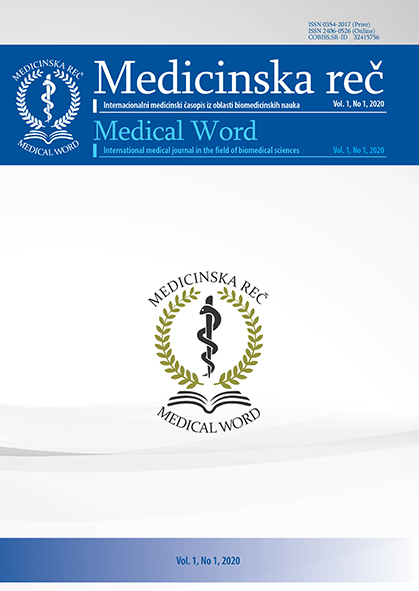Application of the health information system in the Health Center Niš
Abstract
Medical informatics is the science that studies the creating, transmitting, processing and using information, data and knowledge to solve medical problems. It is medical technology due to participation in the process of formal medical decision making. The first step in the development of health information systems in Serbia is the adoption of a national “Strategy for the Development of the Information Society in the Republic of Serbia by 2020”.
The aim of this paper is to consider the advantages of using information technologies in the process of health care provision in health care institutions in comparison to the previous, classical way of collecting, analyzing and interpreting data in the example of primary health care institutions.
The methodology is a retrospective study of the presentation of implementation in information technologies on the example of the Health Center Niš for the period from 2004. to 2019. and presentation of the computer equipment status.
The implementation of the health information system will enable: better and more efficient access to patient information, faster diagnostics, faster and more reliable selection of medicines, greater patient safety, more time for health care employees, better and more complete health-statistical reporting and faster transfer of biomedical knowledge. The introduction of a health information system will allow the creation of an electronic health record and electronic medical history.
In 2011, the Health Center Niš became a user of the medical information system MEDIS.NET, which was realized in the Laboratory for Medical Informatics of the Faculty of Electronic Engineering in Niš. The Adult Health Service and the Child and School Health Services were the first to use electronic records.
References
Puđa N. Zdravstveni informacioni sistem, savremena organizacija zdravstva. Vršac, 2006.
Jha KA, DesRoches MC, Kralovec P, Joshi SM. A Progress Report On Electronic Health Records In US. Hospitals Health Affairs 2010; 29(10): 1951–7.
Biočanin R, Danelišen D, Kozomora R. Menagement u e-zdravstvu. Beograd: Centar za statistička istraživanja nacionalne bezbednosti; 2004.
Beeuwkes Buntin M, Burke FM, Hoaglin CM, Blumenthal D. The Benefits Of Health Information Technology: A Review Of The Recent Literature Shows Predominantly Positive Results. Health Aff (Millwood) 2011; 30: 464–71.
Wrenn OJ, Stein MD, Bakken S, Stetson DP. Quantifying clinical narrative redundancy in an electronic health record. J Am Med Inform Assoc 2010; 17: 49–53.
Centers for Medicer and Medicaid Services. Medicare and Medicaid programs: Electronic Health Record Incetive Program. Baltimor (MD): CMS; 2010 Jul 13. Available from: http://cms.gov//EHrcentivePrograms/
Urošević V. Minimalni skup podataka. Standardi EZD. Dnevnik nacionalnog koordinatora. EHR. Buduće mogućnosti. Projektna konferencija-Sava Centar Beograd. 17. april 2008.
Lawrence OG. Privacy and Security of Personal Information in a New Health Care System. JAMA 1993; 270(20): p. 2487.
Rovner JA. Don’t Let Fear of HIPAA Keep You From Crucial Data. Managed Care 2003; 12: 56–7.
Jevtović BT, Petrović MLj, Oklobdžija DJ. Razvoj i realizacija baznog hijerarhijskog nivoa bolničkog informacionog sistema u NET tehnologiji. Available from: http://www.e-drustvo.org/proceedings/YuInfo2007/html/pdf/143.pdf
DesRoches CM, Campbell EG, Vogeli C, et al. Electronic health records limited successes suggest more targeted uses. Health Aff (Millwood) 2010; 29(4): 639–46.
Zegers M, De Bruijn CM, Spreeuwenberg P, Wagner C, Groenewegen PP, Van der Wal G. Quality of patient record keeping: an indicator of the quality of care? BMJQS 2011; 20: 314–8.
Kostić P. Zaštita ličnih informacija u medicinskim informacionim sistemima, Naučno stručno savetovanje ZITEH, 2004.

